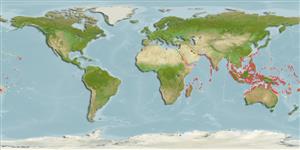Common names from other countries
Classification / Names / Names
Nomi Comuni | Sinonimi | Catalog of Fishes (gen., sp.) | ITIS | CoL | WoRMS
Environment: milieu / climate zone / depth range / distribution range
Ecologia
Associati a barriera corallina; distribuzione batimetrica 3 - 10 m (Ref. 98622). Tropical; 30°N - 27°S, 32°E - 154°W (Ref. 846)
Indo-Pacific.
Length at first maturity / Size / Peso / Age
Maturity: Lm ? range ? - ? cm
Depth range values based on occurrence records (Ref. 98622). A wide variety of environments from exposed upper reef slopes to turbid lagoons (Ref. 846). Also in subtidal protected reef slopes and patch reefs in lagoons (Ref. 98471).
Life cycle and mating behavior
Maturità | Riproduzione | Deposizione | Uova | Fecundity | Larve
Hermaphroditic (Ref. 113712). Mature gametes are shed into the coelenteron and spawned through the mouth. Life cycle: The zygote develops into a planktonic planula larva. Metamorphosis begins with early morphogenesis of tentacles, septa and pharynx before larval settlement on the aboral end (Ref. 833).
Veron, J.E.N. 2000. (Ref. 846)
IUCN Red List Status (Ref. 130435)
CITES status (Ref. 108899)
Not Evaluated
Human uses
| FishSource |
Strumenti
Informazioni ulteriori
Age/SizeAccrescimentoLength-weightLength-lengthMorfologiaLarveAbbondanza
Fonti Internet
Estimates based on models
Preferred temperature
(Ref.
115969): 25.4 - 29.3, mean 28.5 (based on 2914 cells).
Price category
Unknown.
